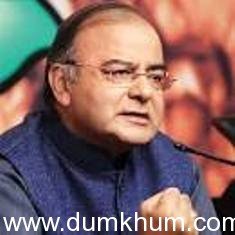Economic Survey forecasts 5.4-5.9% GDP growth during 2014-15
Finance Minister Arun Jaitley today tabled the pre-budget Economic Survey in the Lok Sabha. The Survey has projected a GDP growth of 5.4 – 5.9%, called for prudent management of inflation, fiscal consolidation and urgent measures to revive investment climate in the country.
The highlights:
Growth forecast : 5.4 – 5.9%
Indian economy is likely to grow in the range of 5.4 to 5.9 per cent in 2014-15 overcoming the sub-5 per cent growth of Gross Domestic Product (GDP) witnessed over the last two years. The Survey, released a day ahead of the budget for 2014-15, expects that moderation in inflation would ease the monetary policy stance and revive the confidence of investors, and with the global economy expected to recover moderately, the economy can look forward to better growth prospects in 2014-15 and beyond. As regards the downside risks, the Survey lists factors like poor monsoon, the external environment and the poor investment climate which can have a bearing on the growth recovery.
After recovering in 2009-10 and 2010-11, India’s GDP growth slowed down to decade’s low of 4.5 per cent in 2012-13. It picked up marginally to 4.7 per cent in 2013-14. The Survey further says that the measures taken by the government to improve investment climate and improve governance could push up growth to 7-8 per cent in the coming years.
Record food grains production
As per the third Advance Estimates, the production of food grains is likely to touch a record output of 264.4 million tonnes (mt) in 2013-14 showing an increase of 2.88% over the previous year. Similarly, oilseeds are likely to have a record output of 32.4 mt showing an increase of 4.85% over the previous year. The production of rice is expected to be 106.3 mt and of wheat 95.8 mt. Cotton will touch a production of 36.5 mt in 2013-14. Overall, the agricultural sector is expected to grow at the rate of 4.7% in the year 2013-14.
However, the share of agriculture and allied sector in GDP has declined to to 13.9% in 2013-14 (provisional estimates), while it still accounts for about 54.6% of total employment (Census 2011). There has also been a decline in the absolute number of cultivators, from 127.3 million to 118.7 million (Census 2011).
Industry, services sector remain slack
In industry, the contraction in mining and quarrying for the second year in a row in 2013-14 and the negligible growth in manufacturing over the past two years, indicate the severity of structural bottlenecks. Industry grew by just 1.0 per cent in 2012-13 and slowed further in 2013-14, posting a modest increase of 0.4 per cent. In order to boost manufacturing sector, the government has already announced setting up of sixteen national investment and manufacturing zones (NIMZs). Of these, eight are along the Delhi Mumbai Industrial Corridor (DMIC). The policy focus now needs to target key growth drivers in the short term.
A slowdown is also noticed in services, in particular the internal trade, transport, and storage sectors that are largely attributed to the loss of momentum in commodity-producing sectors, especially, the industry sector.
Reviving investment sentiment – a top priority
The survey points out that the priority of the Government should be the revival of business sentiments in the country. The investment boom in India till 2007-08 was largely due to significant increase in investment by the private corporate sector. The steep reduction in the rate of private corporate investment, leading to slowdown in overall investment rate in the economy, in recent years, point towards the need for revival of business sentiments.
Priorities for growth revival include streamlining implementation procedures to restart the investment cycle; simplification of tax policy, repeal of archaic laws governing market access, expansion and entry/exit of firms and revamp of the dispute resolution mechanism for commercial disputes to lend greater predictability to policy; boost to physical infrastructure; and, reforms that enhance productivity in agriculture, etc. are crucial.
Foreign Trade :
During FY 2013-14 India’s trade deficit recorded a sharp decline. The export-import deficit bridged in by 27.8%, from US$190.3 billion during 2012-13 to $137.5 billion. The sharp fall in trade deficit was largely due to a fall in imports of gold and capital goods as non-Oil import deficit fell sharply to $35 billion from $87.2 billion during the previous FY. In 2013-14 India’s exports stood at $312.6 billion as against the targeted $325 billion.
Improvements in Current Account and Fiscal deficits
The survey notes that external sector witnessed a remarkable turnaround after the first quarter of 2013-14 and the year ended with a Current Account Deficit of 1.7 per cent of GDP as against 4.7 per cent in 2012-13. Improvement is also observed on the fiscal front, with the fiscal deficit declining from 5.7 per cent of GDP in 2011-12 to 4.9 per cent in 2012-13 and 4.5 per cent in 2013-14. India’s foreign exchange reserves increased from US $ 292.0 billion at end March 2013 to US $ 304.2 billion at end march 2014.
FDI :
During 2013-14, FDI inflow (including equity inflows, reinvested earnings and other capital) was US$ 36.4 billion.
Financial sector reforms
The Economic Survey says that the factors impeding the pace of smooth monetary policy transmission to the credit market include rigidities in repricing for fixed deposits, size of government borrowings, level of non-performing assets (NPAs), high inflation and the significant presence of informal finance. It further mentions that the next wave of reforms will be through strengthening the institutional foundation – both laws and organizations – improving and polishing the financial processes; and by taking well-designed policy decisions that will enhance clarity, consistency, and transparency for a globalized India.
Inflation
Inflation showed signs of receding with average wholesale price index (WPI) inflation falling to a three-year low of 5.98 per cent during 2013-14, compared to 7 and 9% over the previous two years. Consumer price inflation, though higher than the WPI, has also exhibited signs of moderation with CPI (new-series) inflation declining from 10.21 per cent during FY 2013-14 to about 9.49 per cent in 2013-14. Food inflation, however, remained stubbornly high during FY 2013-14, reaching a peak of 11.95% in third quarter.
Public Finance
The Survey emphasizes the need for creating a framework for low and stable inflation, setting public finances on a sustainable path by tax and expenditure reform, and creating legal and institutional framework for a well-functioning market economy. To this end, it calls for fiscal correction, a new Fiscal Responsibility and Budget Management (FRBM) Act with teeth, better accounting practices, greater transparency and improved budgetary management.
The Survey recommends a tax regime that is simple, predictable and stable consisting of a single-rate Goods and Services Tax (GST), fewer exemptions in direct taxes, and a transformation of tax administration. Replacing all existing indirect taxes by the GST will create a national market, eliminate cascading taxes, and align taxation of imports and exports correctly, the survey notes.
Poverty ratio
The poverty ratio (based on the Monthly Per Capita Expenditure (MPCE) of Rs.816 for rural areas and Rs. 1000 for urban areas in 2011-12 at all India level), has declined from 37.2 per cent in 2004-05 to 21.9 per cent in 2011-12. In absolute terms, the number of poor declined from 407.1 million (40.71 crores) in 2004-05 to 269.3 million (26.93 crores) in 2011-12 with an average annual decline of 2.2 percentage points during 2004-05 to 2011-12.
HDI
The existing gap in health and education indicators in India as compared to developed countries and also many of the developing countries highlights the need for much faster and wider spread of basic health and education. Life expectancy at birth was 65.8 year compared to 81.3 year in Norway, 73.7 year in China and 75.1 year in Sri Lanka as per HDR 2013. The Indian performance in mean years of schooling (4.4 years) is even below that of Bangladesh and Pakistan which have lower per capita incomes. India has slipped down in HDI with its overall global ranking at 136 (out of the 186 countries) as against 134 (out of 187 countries) as per the United Nations Human Development Report 2012.
PIB Mum | MD.








